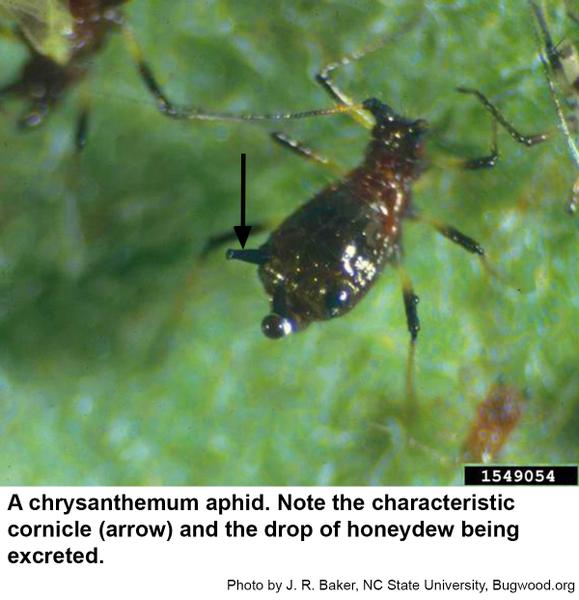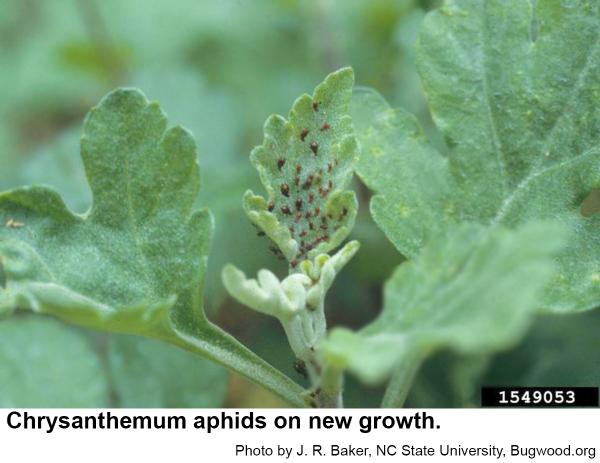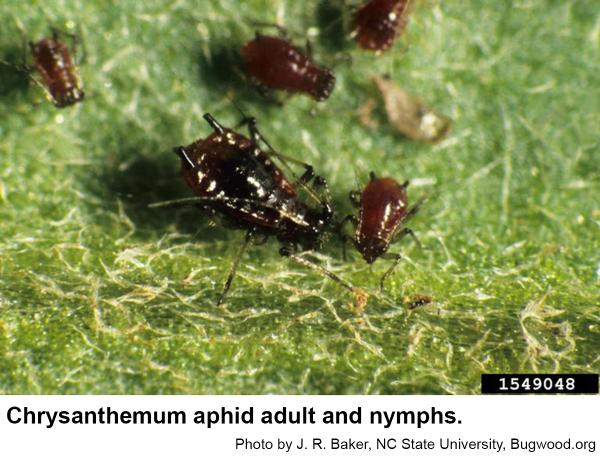Description and Biology
Chrysanthemum aphids, Macrosiphoniella sanborni, were once called "blackflies" because of their dark color. Winged adults are about 1/16 inch long, fragile and shining mahogany brown. Wingless adults are slightly smaller than winged ones. A pair of small, black, sturdy cornicles are found near the end of the body. Nymphs resemble smaller versions of wingless adults. Nymphs have a dull, brick-red bodies with relatively long legs and antennae. The cornicles are short and dark. The outer two-thirds of the legs and antennae are gray (young nymphs) to dark gray. Older nymphs have proportionally longer cornicles. Those destined to be winged adults have wing buds in their later stages. Chrysanthemum aphids feed by piercing the plant surface with threadlike mouthparts to suck out plant juices. They gather about the terminal buds and feed on the new growth. Only female chrysanthemum aphids are known. They reproduce by giving live birth to more females—without mating. Chrysanthemum aphids overwinter in greenhouses where they feed throughout the winter. During the warmer mounts they leave the greenhouses in search of new plants. They also may be moved about as plants are shipped or sold. When the winged female stage infests new plants, it usually starts feeding and producing live nymphs. Each female can produce four to eight young aphids per day. Within about a week the new nymphs mature into wingless females that begin to bear young of their own. One aphid on a plant in a short time may build the population up to hundreds of individuals. As the plant becomes crowded, more and more of the offspring develop into winged females that may migrate to other plants to begin new infestations.
Host Plants
Chrysanthemum is the only known host for this aphid in North America, but it has been reported on a few related plants in Asia. Feeding causes distorted growth and the leaves may be covered by honeydew and cast skins. Sooty mold may grow on the honeydew giving the leaves and stems a black appearance. Chrysanthemum aphids are able to transmit chrysanthemum vein mottle virus and chrysanthemum virus B.
Residential Recommendations
Chrysanthemum aphid populations increase dramatically because they reproduce parthenogenetically once they reach a suitable mum plant. Parasitic wasps, lady beetles, syrphid fly maggots, lace wings and other predaceous insects feed on aphids so that aphid populations often decrease rapidly as well. Aphid populations are sometimes devastated by Cephalosporium lecanii, a fungus that infects aphids as a sort of super-athlete's foot disease. Because ornamental plants are somewhat sensitive to pesticides, be sure to water the plants thoroughly before spraying them and to treat them early in the morning or late in the evening so that the pesticide residue is dry before the plants are exposed to direct sunlight. One of the insecticidal soaps or horticultural oils should give more than adequate control of chrysanthemum aphids although a number of other pesticides are labeled for residential use and should also give adequate control.
References
- Aphids on Ornamental Landscape Plants. Steven Frank. 2009. Entomology Insect Notes, NC State Extension Publications.
- Insect and related Pests of Flowers and Foliage Plants. Baker, J. R., ed. 1994. NC Cooperative Extension Service Publication AG-136. 106 pp.
- Greenhouse Pests of Maryland. Gahan, A. B. 1907. Maryland Agricultural Experiment Station Bulletin No. 119. 36 pp.
- Extension Plant Pathology Publications and Factsheets
- Horticultural Science Publications
- North Carolina Agricultural Chemicals Manual
For assistance with a specific problem, contact your local Cooperative Extension Center
This Factsheet has not been peer reviewed.
Publication date: May 30, 2016
Reviewed/Revised: Sept. 11, 2019
Recommendations for the use of agricultural chemicals are included in this publication as a convenience to the reader. The use of brand names and any mention or listing of commercial products or services in this publication does not imply endorsement by NC State University or N.C. A&T State University nor discrimination against similar products or services not mentioned. Individuals who use agricultural chemicals are responsible for ensuring that the intended use complies with current regulations and conforms to the product label. Be sure to obtain current information about usage regulations and examine a current product label before applying any chemical. For assistance, contact your local N.C. Cooperative Extension county center.
N.C. Cooperative Extension prohibits discrimination and harassment regardless of age, color, disability, family and marital status, gender identity, national origin, political beliefs, race, religion, sex (including pregnancy), sexual orientation and veteran status.



